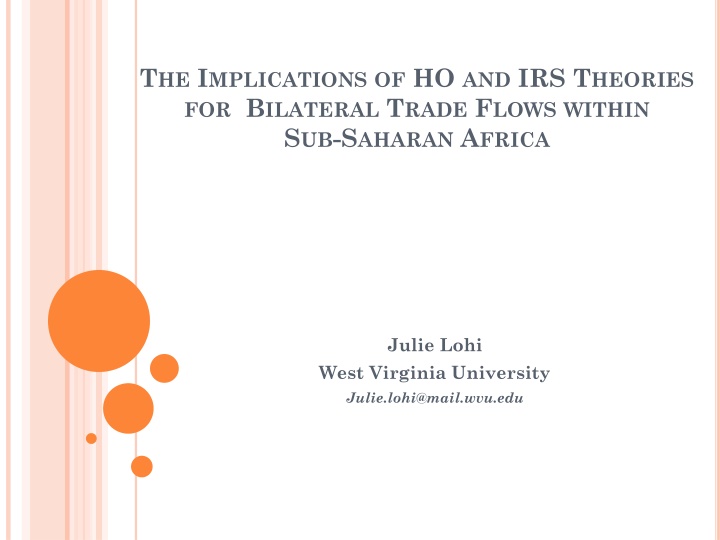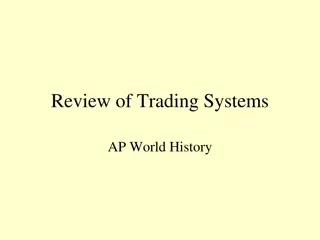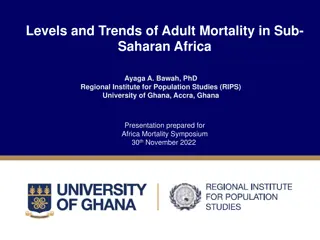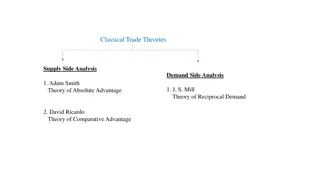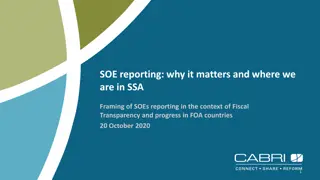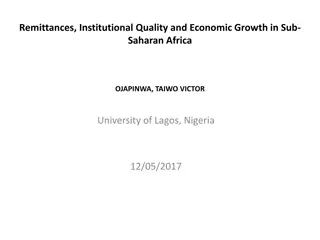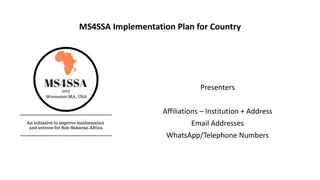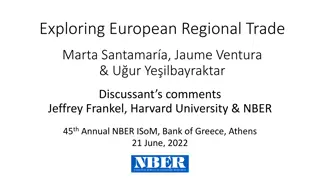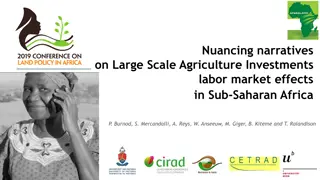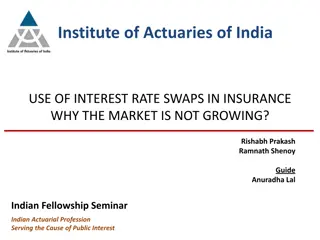Implications of HO and IRS Theories on Bilateral Trade Flows in Sub-Saharan Africa
Low bilateral trade flows within Sub-Saharan Africa and the underlying factors contributing to this phenomenon. Delve into the Heckscher-Ohlin Theory, increasing returns to scale theory, and methodologies used to analyze trade patterns in the region.
Uploaded on Feb 23, 2025 | 1 Views
Download Presentation

Please find below an Image/Link to download the presentation.
The content on the website is provided AS IS for your information and personal use only. It may not be sold, licensed, or shared on other websites without obtaining consent from the author.If you encounter any issues during the download, it is possible that the publisher has removed the file from their server.
You are allowed to download the files provided on this website for personal or commercial use, subject to the condition that they are used lawfully. All files are the property of their respective owners.
The content on the website is provided AS IS for your information and personal use only. It may not be sold, licensed, or shared on other websites without obtaining consent from the author.
E N D
Presentation Transcript
THE IMPLICATIONS OF HO AND IRS THEORIES FOR BILATERAL TRADE FLOWS WITHIN SUB-SAHARAN AFRICA Julie Lohi West Virginia University Julie.lohi@mail.wvu.edu
MOTIVATION Why Bilateral trade Flows are Low within Sub- Saharan Africa (SSA)?
LITERATURE Hanink and Owusu (1998) Used trade intensity index (TII) Find that ECOWAS has failed to promote trade Alemayehu and Haile (2008) Regional grouping has insignificant effects on bilateral trade flows in SSA. Reasons: poor private participation, compensation issue. Faezeh and Pritchett (2009) Trade flows are low within SSA Gravity prediction similar to actual trade Piet and Wheeler (2010) Transport infrastructure and border restrictions are main reasons for lower trade rate in SSA
CONTRIBUTIONS Trade evaluation based on imperfect specialization in production Show that comparative advantages matter in stimulating trade SSA countries exhibit similar endowments Products are not differentiated in the region 4E+10 Trade in Differentiated Good Vs. Homogeneous Goods in SSA 3.5E+10 3E+10 2.5E+10 Differentiated goods Trade Value Homogeneous goods 2E+10 Linear (Differentiated goods) 1.5E+10 Linear (Homogeneous goods) 1E+10 5E+09 0 Year 1996 1998 2000 2002 2004 2006 2008
UNDERLYING TRADE THEORIES Heckscher-Ohlin Theory: Heckscher (1919) and Ohlin (1933) Predicts high trade for large differences in factor endowment ratios. Increasing return to scale theory: Krugman (1979, 1980) Predicts intensive trade between industries producing different varieties of a product. The love of varieties creates demand across countries.
METHODOLOGIES A- Build on Evenett and Keller (2002) to estimate the gravity equation for 118 countries grouped into 5 regions (1), (2), (3), (4) Where ???,??,??, ??,??? ??are respectively imports of country i from country j, GDP of country i, j, world and region; ????is importing country s specifics; ????,????,????????,??? ???represent respective dummies for common language, colony, contiguity, and landlocked; ???is the log of distance between country i and j.
METHODOLOGIES B- Compute the Grubel Lloyd index as: ??= 1 [ ?? ?? ?? ??+ ?? ??], 0 < ???? 1, ??? ??? ??? where, ? represents a commodity, ???? the Grubel Lloyd index reflects the intra industrial trade (imports and exports) of country ? from (to) country ?. ?? export value from country ? to country ? in differentiated ?? goods ?? imports value in good ? of country ? from ?. ??
METHODOLOGIES C- Assess capital (?) to labor (? ) ratio difference within each region Compute each pair of countries ? ? for each country and the difference between
DATA 118 countries across the world grouped into 5 regions: Asia, Europe and North America, Latin America and Caribbean, Middle East and North Africa, and Sub-Saharan Africa. Panel from 1997 to 2007 Data on bilateral imports is extracted from the IMF-DOT Data on Real GDP, Investment Share, Real GDP per worker, and population are taken from the Penn World Tables (last version- 6.3) Data on trade factor dummies can be found at http://www.cepii.fr/anglaisgraph/bdd/distances.htm Capital stock and labor force data are from the World Bank s World Development indicator (WDI) database The Grubel Llyod is calculated using Uncomtrade data at 3-digit.
RESULTS Table 1: Testing Factor Endowments and the Comparative Advantage in SSA Country Name Angola Benin Burkina Faso Burundi Cameroon Cape Verde 1CAF Chad Comoros 2DRC Congo, Republic C te d'Ivoire Equatorial Guinea Ethiopia Gabon Gambia Ghana Guinea Guinea-Bissau Kenya Liberia Madagascar Malawi Mali Mauritius Mozambique Niger Rwanda Senegal Sierra Leone South Africa Tanzania Togo Uganda Zambia Zimbabwe 1Central African Republic 1997 K L L L K K 1998 K L L L K K 1999 K L L L K K 2000 K L L L K K 2001 L L L L K K 2002 K L L L K K 2003 L L L L K K 2004 L L L L K K 2005 L L L L K K 2006 K L L L L K 2007 K L . . L K L L L L L L L L L L L L L L L L K L L L L L K L L L L L L L L L L L K K K L K L L L L L . L L L K L L L L L K L L L L K L K K K L K L L L L L . L L L K L L L L L K L L L L L L K K . L K L L L L L . L L L K L L L L L K L L L L L L K L K L K L L L L L . L L L K L L L K L K L L L L L L K L K L K L L L L L L L L K K L L L K L K L L L L L L K L K L K L L L L L L L L L K L L L K L K L L L L L L K L K L K L K L . L L L L L K L . L K L K L . L K L L K L K L K L L L . L L L L K K L L L K L K L L L L L L K L K L K L L L . L L L L L K L L L K L K L L L L L L K L K L K L L L . L L L L L K L L L K L K L L L K L L K L K L K L L L . L L L L L K L . L K L K L . L K L 2Democratic Republic of Congo Note: The score k indicates the abundance of capital over labor in the country for a particular year, while the score L refers to the abundance of labor of capital Source: Author's calculation using WDI database.
RESULTS Table 2: Regional Average Grubel Llyod Index from 1997 to 2007 Mean Minimum Maximum East and South Asia Europe and North America Latin America and Caribbean Middle East and North Africa Sub-Saharan Africa 0.12 0.24 0.06 0.06 0.02 0.00 0.00 0.00 0.00 0.00 0.28 0.43 0.16 0.17 0.11 Source: Author's calculation using UNCOMTRADE data.
RESULTS Table 3: Statistics on SSA Countries' Trade in Differentiated Goods from 1997-2007 2Gli 0.027 0.023 0.031 0.027 0.029 0.027 0.027 0.025 0.026 0.026 0.027 0.023 0.023 0.029 0.021 0.033 0.027 0.021 0.025 0.022 0.022 0.024 0.031 0.025 0.024 0.022 0.022 0.023 0.024 0.022 Reporter Name South Africa Kenya Zimbabwe Mozambique Nigeria C te d'Ivoire Ghana Tanzania Burkina Faso Mali Malawi Mauritius Senegal Togo Uganda Botswana Benin Madagascar Cameroon Guinea Gabon Niger Namibia Rwanda Ethiopia Seychelles Gambia Burundi Sierra Leone Guinea-Bissau 1CAF Comoros Eritrea Cape Verde S o Tom and Pr ncipe 1Central African Republic 2The Grubel Llyod index (Gli) takes the maximum value of 1 for intensive intra industrial trade (importvalue = expport value), the minimum value of the Gli is 0 (in case of only import or export). Lower Gli means less intra industrial trade flows. Import Value (Million $U.S.) Export Value (Million $U.S.) Regional Share (percentage) 42781.6 6502.3 3107.8 1650.9 1153.0 3556.7 246.0 4112.8 644.9 3177.5 3090.1 679.0 609.0 3034.7 475.8 2448.3 309.8 2347.3 73.7 2440.0 366.4 2073.4 906.0 1263.2 1394.0 756.2 1024.2 1103.5 137.8 1584.3 993.6 620.8 652.1 911.7 129.3 1249.1 447.1 819.2 38.9 745.3 126.5 640.5 92.2 504.1 457.8 58.6 20.9 470.7 28.2 416.8 37.1 380.4 32.5 383.3 16.2 306.1 21.7 239.0 28.8 173.2 47.16 4.55 4.51 4.17 3.66 3.61 3.49 2.80 2.54 2.41 2.33 2.08 2.06 2.04 1.65 1.54 1.50 1.32 1.21 0.75 0.73 0.57 0.49 0.47 0.43 0.40 0.40 0.31 0.25 0.19 4.5 3.5 18.2 14.3 7.6 145.3 119.8 41.1 38.3 10.3 0.14 0.12 0.06 0.05 0.02 0.020 0.021 0.024 0.022 0.026 Source: Author's calculation using UNCOMTRADE data.
RESULTS Table 6: Estimation of Equation (4) using the Hausman- Taylor Methodology Variables Asia EU_NAM HTaylor LAC HTaylor MENA HTaylor SSA HTaylor HTaylor YiYj/Yr 0.339*** (0.028) 0.153 (0.238) 0.050*** (0.016) 0.042*** (0.004) 0.041*** (0.013) Dij -4.108* (2.371) -2.983** (1.252) 0.004 (0.046) -0.049 (0.046) -0.033*** (0.012) i -22.835*** -13.077*** -0.532 0.006 Col (7.329) (2.391) (0.396) (0.078) LLi 12.559*** (4.281) -4.139 (2.708) -0.191 (0.193) 0.079*** (0.013) ij -20.833 10.166 0.520** -0.278 -0.118** contig (15.681) (7.713) (0.213) (0.215) (0.056) ij 21.626*** 16.015*** -0.042 0.479*** 0.031 CL (7.522) 29.273 (19.973) (4.931) 23.010** (9.626) (0.158) 0.010 (0.370) (0.104) 0.026 (0.397) (0.021) 0.225** (0.097) Constant Observations Number of groups Wald chi2(31)= prob> chi2= 6,170 606 13564.94 0.0000 9,900 900 3409.09 0.0000 6,339 631 2678.7 Wald chi2(21)= 0.0000 prob> chi2= 2,907 273 1857.51 Wald chi2(41)= 8938.35 0.0000 prob> chi2= 12,135 1,190 Wald chi2(35)= prob> chi2= Wald chi2(31)= prob> chi2= 0.0000 Note: ***, **, and * represent respectively 99, 95, and 90 percent significance. The heteroscedasticity- consistent standard errors are in parentheses.
CONCLUDING REMARKS Bilateral trade flows are low within SSA compare to that of other regions due to: Lack of comparative advantage in production across countries in SSA Similar endowments in factors of production across countries within SSA Homogeneity of traded goods Less product differentiation
SUGGESTIONS SSA countries might want to increase efforts towards accessing developed markets Gain the know-how from interacting with mature markets Benefit from their comparative advantage over industrialized countries Use new technologies for industrialization and differentiate their products in many varieties.
THANK YOU FOR YOUR ATTENTION YOUR COMMENTS ARE VERY WELCOME!
